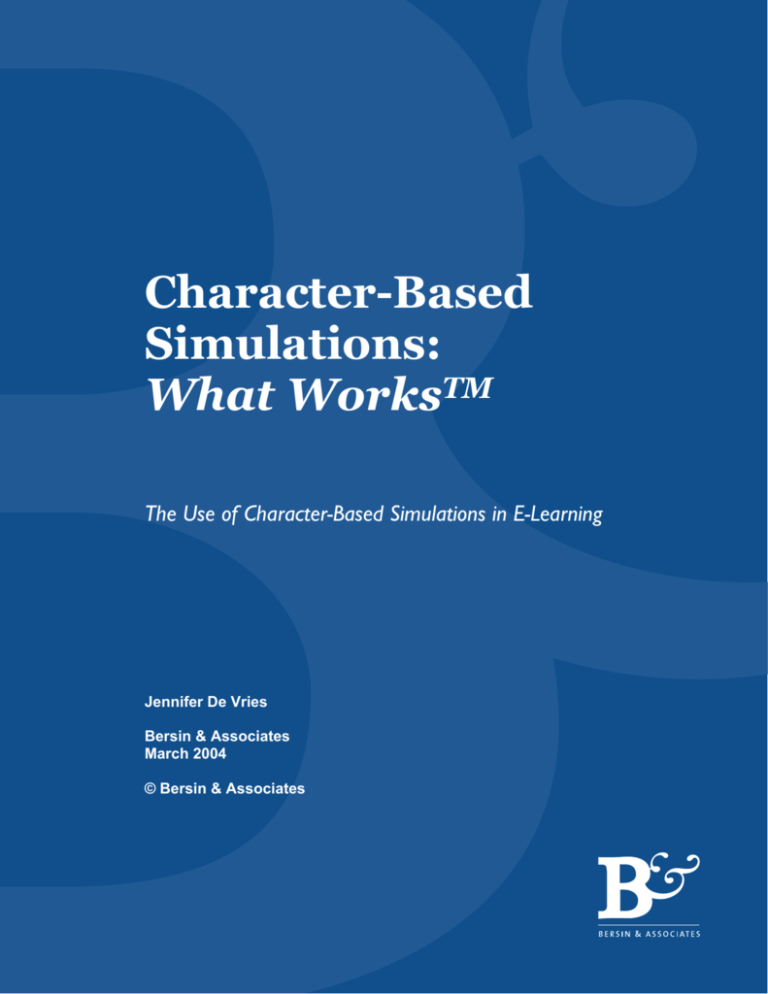
Character-Based
Simulations:
What WorksTM
The Use of Character-Based Simulations in E-Learning
Jennifer De Vries
Bersin & Associates
March 2004
© Bersin & Associates
Character Based Simulations: What Works™ Table of Contents
Table of Contents .............................................................................................................. 2
Character Simulations in E-Learning............................................................................... 3
What is a Character Simulation?...................................................................................... 4
The Three Models for Character Simulations ........................................................................................ 4
Why Use Character Simulations? .................................................................................... 5
Credible Characters Motivate Learners ...................................................................................................5
Characters Create Interest and Fun......................................................................................................... 5
Characters Demonstrate Soft Skills.......................................................................................................... 5
Characters Can Drive Higher Learning Impact...................................................................................... 6
Typical Applications for Character-Based Simulation ................................................... 6
Characters Playing A Role Within Programs.......................................................................................... 7
A Large Nationwide Bank: Training IT to Prepare for Bank Audits............................ 8
Characters Can Make Dry Material Interesting ..................................................................................... 8
Verizon: Training Sales Consultants ............................................................................. 10
E-Learning offers Updates During Unscheduled Downtime.............................................................. 11
Short Online Character-Based Simulations........................................................................................... 11
Tips and Techniques for Character-Based Simulation ................................................ 12
Conclusion: Character Simulations are a Powerful Solution ..................................... 14
About Us .......................................................................................................................... 15
About This Research....................................................................................................... 15
Figure 1: Example of Character Simulation....................................................................6
Figure 2: Bank IT Training Sample ....................................................................................9
Figure 3: Character Explains an Audit Process .......................................................... 10
Figure 4: Verizon Character Explains Order Process............................................... 12
© Bersin & Associates
2
March, 2004
Character Based Simulations: What Works™ Character Simulations in E-Learning
If you teach soft skills, animated characters may help create an immersive environment where learners interact with characters. Over the years, learning professionals have agonized over how to gain the benefits of e‐learning, while maintaining the level of learner engagement that occurs in the classroom. One of the latest developments is the use of animated characters who can engage learners in a way that draws them socially into the e‐learning experience. Peter Orton, Program Director for the IBM’s On‐Demand Learning group has worked with Stanford University on a study that includes research on the benefits of character interfaces. He states: “Immersive learning, like flight simulation, is arguably one of the most effective learning techniques. And for teaching soft skills, animated characters can help create an immersive environment that elicits a learnerʹs social responses. However, weʹve discovered from experiments with Stanford University that characters must be designed to be right for the task and not distracting to the learner. When designing characters, itʹs essential to ensure that all audio, visual and content cues create an experience that both engages the learner and enhances the learning process. Only then can you teach how best to respond in a real‐life situation.” We believe that character‐based simulations are emerging as a key tool and approach to high‐impact e‐learning. A combination of factors is making this approach available to corporate training organizations. This paper discusses our research and findings on “What Works” in this exciting new area. © Bersin & Associates
3
March, 2004
Character Based Simulations: What Works™ What is a Character Simulation?
The idea of a character simulation is to engage the learner in a social experience; where a “person” speaks, interacts, and guides the learning experience. This character is someone who may be a “real personality” (a simulation of a well‐known individual, like the CEO of a company, a client or an expert) or an anonymous character with a real personality. These characters take on a personality through their visual impact, their choice of language, their attitude, and even their voice. The Three Models for Character Simulations
There are three ways characters can be used: • Peer Instructor or Coach: In this approach the character takes on the role of a peer. A sales representative in a retail store, for There are three models example, may see a 19‐year old sales rep talking to him, wearing for character‐based clothes he may wear, and discussing topics in a way he can relate simulations: to. Our case study on Pep Boys Retail e‐learning (available to • Peer Instructor or research subscribers) describes how retail peers are used to engage Coach and train retail employees. • Expert Instructor • Expert Instructor: In this model the character takes on the role as • Authority Figure an expert. The character may be a “sales manager” or “flight instructor” or even Albert Einstein or another well known expert. • Authority Figure: In this model, the character is the “boss.” The character is a manager, authority, or enforcer who tells the learner what they must do. In some applications, such as military training, an authority figure creates more credibility than a peer or expert. © Bersin & Associates
4
March, 2004
Character Based Simulations: What Works™ Why Use Character Simulations?
Creating a character‐based simulation can be complex. What are the real reasons to take this approach? Credible Characters Motivate Learners
One of the biggest benefits of well‐designed characters is credibility. When you are trying to motivate and educate an audience, your program must exude credibility. The learner must trust that the content is useful, correct, relevant, and valuable. Characters Create Interest and Fun
The second big benefit of characters is that they are interesting. If the material itself is dry, technical, or boring a character can “bring it to life.” A character can be entertaining, comical or just interesting to listen to. Characters Demonstrate Soft Skills
A character can demonstrate behaviors and body language, along with what to say, making them a perfect tool for teaching soft skills. Research has repeatedly shown that communication is more about how a message is delivered than the message itself. Therefore, using animated character is a perfect way to demonstrate desired and undesirable behaviors in an interesting and non‐threatening way. For example, if you are teaching retail employees how to handle sales objections, a character can demonstrate two different ways of saying the same words, demonstrating how voice and body language can make a huge difference in the way a message is received. This direct discussion from the character makes the learner feel comfortable and engaged. It also helps you explain the material directly at the learner’s level. © Bersin & Associates
5
March, 2004
Character Based Simulations: What Works™ Characters Can Drive Higher Learning Impact
When learners are interested and engaged, they learn and retain more. One of the biggest flaws in many online programs is their inability to engage the learner. Research has proven that character‐based simulations drive measurably higher rates of completion, learning, retention, and overall job impact. Typical Applications for Character-Based
Simulation
Character simulations are increasingly being used within soft skills programs. We have seen character simulations being used for … • Sales force training • Customer service training • Communication skills • Management training • Organizational change and development programs. Soft Skills Animated characters can be used to effectively simulate human interactions with learners. Figure 1: Example of Character Simulation
© Bersin & Associates
6
March, 2004
Character Based Simulations: What Works™ Characters Playing A Role Within Programs
You do not have to build an entire course around a character. Often you can use the character approach as an instructional strategy for a particular section or topic. For example: • To Provide Motivational Statements ‐‐ At the beginning of most training courses, there’s a motivational segment about what the learners will gain by taking the course. Learners seem to pay more attention to theses benefit statements when they are delivered by an animated character than when they provided by text or audio. • As a Guide for Personalized Learning – One nationwide bank has a program that creates personalized learning roadmaps. They offered their employees a choice between using the program with no guide, having a guide who was a created from a photograph, or having an animated character guide. They found that 80% of the program users preferred to have an animated guide who explained their learning roadmaps. • To Deliver Brief Updates – Companies who use animated characters in e‐learning programs have also found that they can use characters to quickly disseminate brief updates to their employees. In these cases, a character is created who is the spokesperson for the company’s leadership. The character is used to provide everyday news, important notifications, or a message of the week from the executives. © Bersin & Associates
7
March, 2004
Character Based Simulations: What Works™ A Large Nationwide Bank:
Training IT to Prepare for Bank Audits
Bank audits can create havoc on IT processes. One large Bank needed to make sure that all IT developers were familiar with banking regulations and audit processes. The material is dry and rule‐
filled. How could the bank make these courses engaging for this audience? In a bank, audits can happen anytime as a matter of course. At this particular bank, when their Technology Solutions Group builds or modifies an IT system, they need to comply with FDIC regulations and ensure that audits can be done efficiently. Until recently, there was no official training program for IT Professionals to learn relevant banking regulations. When a group of IT professionals architected or modified a system, they would ask their managers about appropriate rules and the associated audits. To make sure that developers were familiar with audit regulations, the IT management team asked Terry, a Resource Development Manager, to put together a self‐paced training program to help IT personnel understand the audit processes and regulations. FDIC regulations are not exactly the type of topic that IT professionals love to learn. However, this is a business critical topic for the bank, since failing an audit can have dire consequences. One of the biggest challenges was to make these courses engaging for this audience. Terry was asked to create a series of short modules that managers could prescribe when an IT team member asked a common question about regulations or audits. The biggest challenge they faced was making this dry, rule‐filled information engaging and easy to understand. Characters Can Make Dry Material Interesting
After doing research about various training media options, the IT training team elected to use animated characters as the primary delivery method for this content. They believed that animated characters would create an interesting, engaging experience that would encourage IT personnel to learn about the audit process on their own, with less assistance from the management team. © Bersin & Associates
8
March, 2004
Character Based Simulations: What Works™ They chose the Oddcast™ platform (www.oddcast.com) to develop the characters and scenes. The Oddcast scenes were then converted into Flash (www.macromedia.com) and integrated with custom Flash files and other media types to form the course. A large bank uses animated within a program to IT professionals about banking regulations. Figure 2: Bank IT Training Sample
According to Terry, “Oddcast was very easy to learn. You don’t need to be a technical guru to develop a scene for an e‐learning program. The best way to learn to create characters is read the manual and play with the program. Creating characters is really fun. There’s a lot you can do with animated characters within a set of training programs.” We think that one of the keys for enhancing dry material with characters is to keep in mind that that the purpose of the character is to build a helpful relationship with the learner. Dull stuff can be just as dull coming out of the mouth of a character, as it is on a text screen, so you need to make the character look and act like the real people who would provide this training on‐the‐job. The learner has to come away from the experience saying, “This character understand me and knows my job. I can learn from this person.” © Bersin & Associates
9
March, 2004
Character Based Simulations: What Works™ Figure 3: Character Explains an Audit Process
Sales consultants at Verizon must respond to a wide variety of customer questions. To attend training, they cannot be scheduled away from their positions for long periods of time. How could Verizon use call center lull‐time to provide ongoing updates and additional training to these important workers? Verizon: Training Sales Consultants
At Verizon, one of the most important roles in the company is the Communications Consultant. These employees make or break sales by discussing communication needs with customers and prospective customers. Customers who call this center have a wide variety of questions about telecommunication options and this requires that consultants are trained to listen, ask relevant questions and recommend an appropriate solution. © Bersin & Associates
10
March, 2004
Character Based Simulations: What Works™ E-Learning offers Updates During Unscheduled Downtime
These employees were traditionally trained in the classroom to give them practice responding to customer situations. Classroom training is difficult to schedule, because it requires advanced planning for the call center to maintain coverage during class time. In addition classroom training is not enough: Verizon consultants need continuous updates when products and services change, as well as additional learning and growth opportunities. According to Miriam Martin, Training and Development Specialist for Sales Operation and Support, “We wanted to leverage small pockets of consultant downtime. The flexibility to train when the opportunity arises and the ability to grow our consultants’ skills on a moment’s notice is critical to maintaining our competitive position. We have lulls where 20 people are available for a ½ hour and it is to our advantage to make good use of that time.” Short Online Character-Based Simulations
Verizon created two 30‐minute training modules, using Oddcast character simulations, which cover key aspects of the Verizon sales and marketing strategy. Consultants at Verizon use small amounts of downtime to take this training, which emphasizes the importance of customer relationships. According to Miriam, the character‐based online program complements their instructor‐led training: “This program doesn’t eliminate the face to face classroom training; it enhances it. The animated characters pull people in. This seems to be an effective way to reinforce the skills we’ve taught in the classroom.” © Bersin & Associates
11
March, 2004
Character Based Simulations: What Works™ Figure 4: Verizon Character Explains Order Process
Tips and Techniques for Character-Based
Simulation
When using character simulations within e‐learning courses, there are a number of unique factors to keep in mind. • Create Life‐Like Characters – In creating an animated character, be deliberate about characteristics that might seem minor and non‐
instructional. Clothing style, speech and idioms, hairstyles and especially voices, can make a big difference in the perception of the A well‐designed character by the target audience. A well‐designed character can character can become a much loved icon in your company. Before you design a become a much loved icon in your whole program, create one or more characters and test whether the company. target audience likes and accepts them. © Bersin & Associates
12
March, 2004
Character Based Simulations: What Works™ •
•
•
•
•
•
© Bersin & Associates
Plan the Scenes Prior to Development – Like other forms of animation, character simulations are built in scenes. In general, scenes will be one minute or less. Create a plan for your scenes and when you put them together, think about pacing them appropriately for the learners. Storyboarding techniques can be very helpful in the planning process. Check for Understanding – Just like in other types of e‐learning, delivering the information without appropriate user interaction is not sufficient for learning purposes. When you use character simulations, make sure that you design the program so that the characters interact with the learner to verify that the objectives are being met. Have the character simulate common situations and use questions to gage if the learner would respond appropriately. Focus on Learning Objectives – Get to the point quickly. Character development products are full‐featured, fun and fascinating. Don’t let the product features and functions distract you. This may seem like common sense to a training professional, but it’s easy to get sidetracked with these products. Use Text to Speech before Final Script – When you create the audio, create a script first, and use text to speech until your script is finalized. Once the script is finalized, record the audio with a real voice. For major, high stakes programs, hire a professional to record the voiceover. Consider a Multi‐Skilled Team – To do a full blown e‐learning program that integrates character simulations into your courses, you will need several types of skills. 1) Writer or Developer who can create storyboards and write scripts. 2) Graphic Artist who can develop backgrounds and other artwork. 3) Web developer who can integrate all the files, including Flash, wave, and graphic files. Pilot Test to Gather FAQs – In many cases, character simulations are substituting for interactions with real people. It is important that the characters can answer normal questions that come up in the course of learning the material. Use your pilot test as an opportunity to gather these questions and make sure they are answered in your program. 13
March, 2004
Character Based Simulations: What Works™ Conclusion: Character Simulations are a
Powerful Solution
Character‐based simulations are emerging as a key approach to e‐learning. With a character‐based simulation you can create excitement, stickiness, and engaging content. Through the three models we describe in this paper, you can tune your program directly to the audience. A variety of factors is making this approach more and more common: ¾ New tools to make character‐creation easy. Tools like Oddcast’s [V]‐Host™ platform make character creation, editing, and animation easy. You do not have to be a Flash‐developer to create an engaging character. ¾ Widespread use of Macromedia Flash. Flash technology enables users to view animated graphics using vector technology, which makes character‐animation fast and easy on low to moderate bandwidth connections. More than 90% of all browsers use Flash today, making it easy to develop for a broad audience. ¾ Bandwidth availability. Most e‐learning users have 56K modems or higher bandwidth today, making it possible to create animated characters with voice which work well in most environments. Only a year or two ago bandwidth limitations made such an approach difficult to deploy. © Bersin & Associates
14
March, 2004
Character Based Simulations: What Works™ About Us
Bersin & Associates is a leading provider of corporate and vendor consulting services in e‐learning technology and implementation. With more than 20 years of experience in e‐learning, training, and enterprise technology, Bersin & Associates provides a wide range of services including industry research, corporate workshops, and corporate implementation plans. Some of Bersin & Associates’ innovations include a complete methodology for LMS selection and application usage, an end‐
to‐end architecture and solution for e‐learning analytics, and one of the industry’s largest research studies on blended learning implementations. Bersin & Associates can be reached at http://www.bersin.com or at (510) 654‐8500. About This Research
Copyright © 2004 Bersin & Associates. All rights reserved. What Works™ and related names such as Character Simulations: What Works™ is registered trademarks of Bersin & Associates. No materials from this study can be duplicated, copied, republished, or re‐used without written permission from Bersin & Associates. © Bersin & Associates
15
March, 2004








